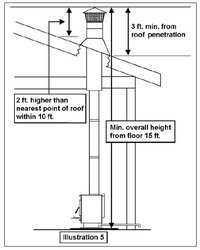I thought i had read some place in the stove manual that a chimney including all pipe should be at least 14 feet. My chimney is a straight shot from the stove out through the roof with no bends or elbows. Do you expect I'll have draft problems. I do have a 3" fresh air intake connected from the stove to the outside. At this 12' length my chimney is 3 feet over the ridge as i have a very low pitched roof.
Thanks for any feedback
Thanks for any feedback


